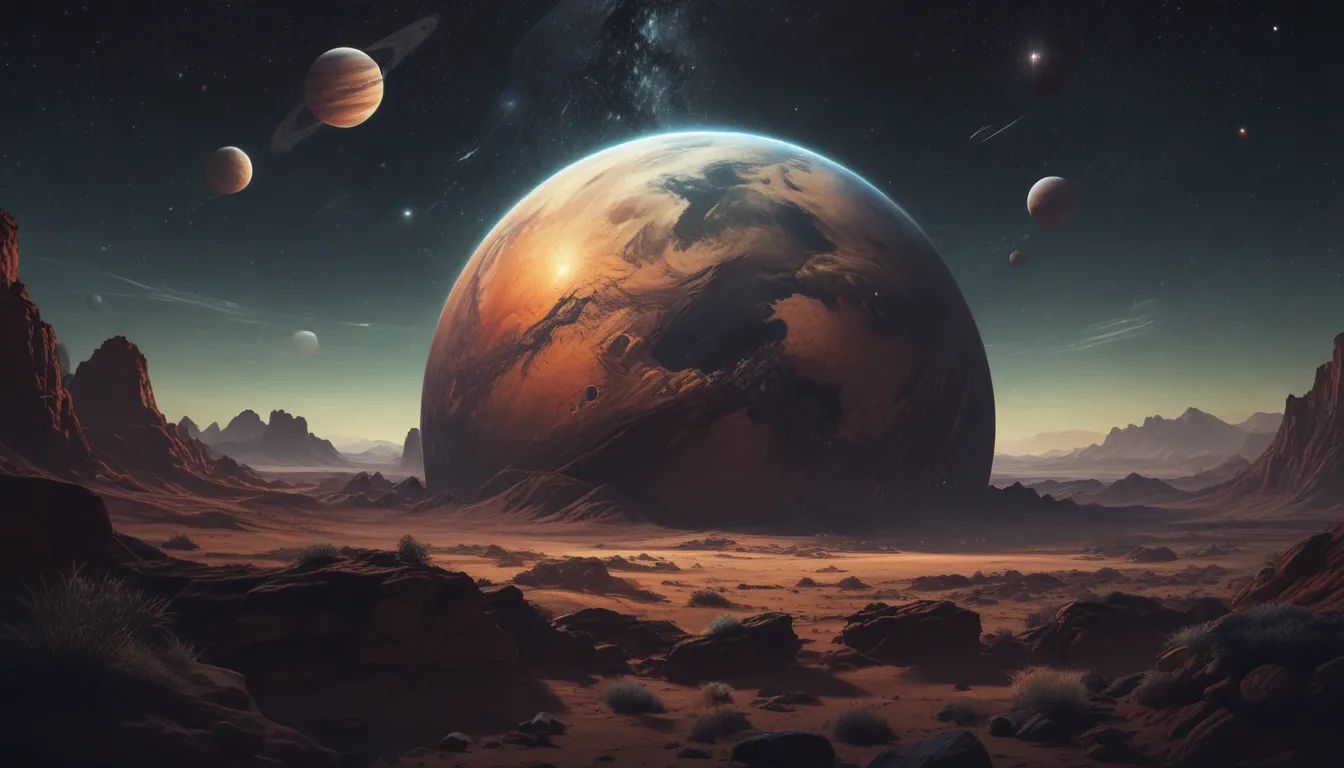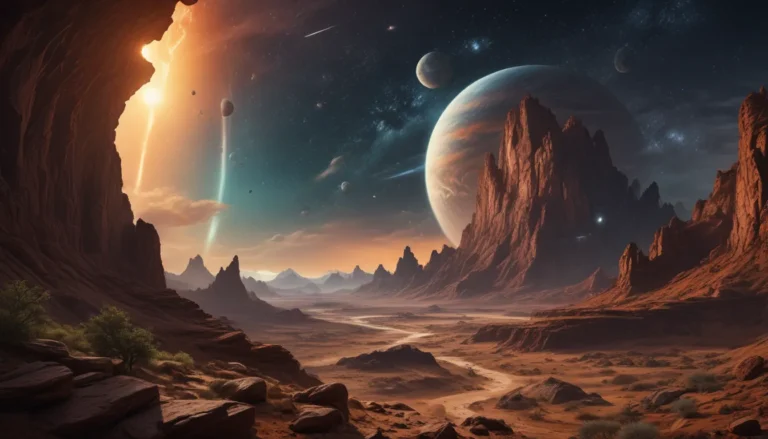The pictures we use in our articles might not show exactly what the words say. We choose these pictures to make you interested in reading more. The pictures work together with the words but don’t take their place. The words still tell you the important facts.
Are you ready to embark on an exciting journey through the cosmos? Planetary science, the captivating study of celestial bodies within our solar system and beyond, offers a wealth of fascinating discoveries waiting to be explored. Whether you're a seasoned star-gazer or simply curious about the mysteries of the universe, these 20 captivating facts about planetary science will ignite your curiosity and deepen your understanding of the incredible diversity and complexity of our cosmic neighborhood.
Exploring the Planets and Moons
Planetary science is a universe of extreme temperatures, hidden oceans, and endless exploration. Let's dive into some of the most captivating facts about the planets and moons that inhabit our solar system.
The Tallest Volcano in the Solar System - Olympus Mons on Mars
Mars, the red planet, is home to Olympus Mons, a colossal shield volcano that towers about 13.6 miles (22 kilometers) high. This volcanic giant is three times the height of Mount Everest, making it the tallest volcano not only on Mars but in the entire solar system.
Jupiter's Centuries-Old Storm - The Great Red Spot
Jupiter, the gas giant, boasts a swirling storm known as the Great Red Spot that has been observed for over three centuries. This massive storm is so vast that Earth could fit inside it three times over, leaving scientists intrigued by its fascinating dynamics.
Extreme Temperature Fluctuations on Mercury
As the closest planet to the Sun, Mercury experiences extreme temperature variations. During the day, temperatures on Mercury can soar to scorching highs of up to 800 degrees Fahrenheit (430 degrees Celsius), while at night, temperatures plummet to a bone-chilling -290 degrees Fahrenheit (-180 degrees Celsius).
Saturn's Stunning Rings - Composed of Ice and Rock
Saturn, the ringed planet, is encircled by dazzling rings made up of countless particles of ice and rock. Ranging in size from tiny specks to massive chunks several meters in diameter, these rings provide endless fascination and beauty for planetary scientists and enthusiasts alike.
Uranus - The Sideways Spinner
Unlike most planets that spin on an invisible axis perpendicular to their orbital plane, Uranus is tilted on its side, giving it a unique appearance of rolling along its orbit. This sideways spin sets Uranus apart from the rest of the planets in our solar system.
The Moon-Rich Planet - Over 170 Known Moons Orbit Jupiter
Jupiter, the largest planet in our solar system, boasts an impressive collection of over 170 known moons. Among these moons, the four largest – Io, Europa, Ganymede, and Callisto – are known as the Galilean moons, captivating planetary scientists with their diverse characteristics.
Venus - The Hottest Planet in the Solar System
Venus, shrouded in a thick and toxic atmosphere predominantly composed of carbon dioxide, boasts surface temperatures that soar to a blistering 900 degrees Fahrenheit (475 degrees Celsius). This extreme heat makes Venus the hottest planet in our solar system, showcasing the effects of a runaway greenhouse effect.
Earth - Our Precious Oasis of Life
Our beloved Earth stands out as the only known celestial body capable of supporting life. With its perfect balance of atmosphere, water, and an optimal distance from the Sun, Earth provides a unique and nurturing environment for the flourishing of diverse life forms, making it a precious oasis in our cosmic neighborhood.
Martian Landscapes of the Past - Ancient Rivers and Lakes on Mars
Evidence of ancient rivers, lakes, and oceans on Mars suggests that the red planet was once a warmer and wetter world. Channels, valleys, and rocks sculpted by ancient water flows hint at a history rich with flowing rivers and bodies of water on Mars.
Neptunian Mystery - Emitting More Heat Than Received from the Sun
Neptune, the eighth planet from the Sun, puzzles scientists by emitting more heat energy than it receives from our star. This phenomenon is attributed to internal heat generated by gravitational contraction and residual heat from Neptune's formation, highlighting the complex dynamics of this distant ice giant.
Moons of Mystery and Intrigue
Exploring the moons of our solar system reveals hidden oceans, subsurface lakes, and the potential for life beyond Earth. Let's delve into the fascinating characteristics of some of these captivating moons.
Enceladus - Saturn's Geyser-Flushing Moon
Saturn's moon, Enceladus, captivates scientists with its subsurface ocean of liquid water and active geysers erupting from its icy surface. This intriguing moon presents a promising candidate in the search for life beyond Earth, offering tantalizing clues to its habitable potential.
Europa - Jupiter's Ocean World Beneath the Ice
Jupiter's moon, Europa, harbors a global ocean beneath its icy crust, maintained in a liquid state by tidal heating. This vast ocean makes Europa one of the most intriguing destinations in our solar system for the search for extraterrestrial life, sparking excitement and curiosity among planetary scientists.
The Moon - Earth's Loyal Companion
As Earth's only natural satellite, the Moon plays a crucial role in stabilizing our planet's axial tilt and providing us with the mesmerizing phenomenon of lunar phases. This loyal companion, the fifth-largest moon in the solar system, has enchanted humanity for millennia with its beauty and mystery.
The Solar System’s Secrets Unveiled
From the scorching landscapes of Venus to the icy depths of Neptune, the planets of our solar system hold a wealth of wonders waiting to be explored. Let's uncover more fascinating facts about these celestial bodies and their intriguing characteristics.
From Planet to Dwarf - Pluto's Reclassification
Once considered the ninth planet in our solar system, Pluto was reclassified as a "dwarf planet" by the International Astronomical Union in 2006. This reclassification sparked a debate about the criteria for defining a planet, reshaping our understanding of the distant worlds beyond Neptune.
Earth's Oceanic Giant - Mauna Loa's Solar System Dominance
Mauna Loa, located in Hawaii, holds the title for the largest volcano on Earth. When measured from its base on the ocean floor, this towering volcano surpasses Olympus Mons on Mars, earning it the distinction of being the largest volcano in the entire solar system.
The Dominant Sun - Overshadowing the Solar System
Accounting for a staggering 99.86% of the total mass of our solar system, the Sun stands as the dominant figure in our cosmic neighborhood. Its immense gravitational influence shapes the orbits of planets, moons, asteroids, and other celestial bodies, underscoring its central role in the dynamics of our solar system.
Mars - Home to Giant Volcanoes and Deep Canyons
In addition to hosting Olympus Mons, the tallest volcano in our solar system, Mars boasts Valles Marineris, the largest canyon stretching for about 2,500 miles (4,000 kilometers) and plunging to depths of up to 7 miles (11 kilometers). These geological features on Mars offer a glimpse into the planet's turbulent past and dynamic evolution.
Saturn's Mighty Storm - The Great White Spot
The storm known as the "Great White Spot" periodically appears on Saturn approximately once every 30 Earth years, spanning thousands of kilometers and lasting several months. This massive storm system covers a significant portion of Saturn's surface, showcasing the planet's dynamic and ever-changing atmosphere.
Unraveling the Mysteries of Planetary Science
To study and explore the planets and moons of our solar system, scientists rely on a sophisticated array of spacecraft and telescopes. These technological marvels enable us to unravel the mysteries of our cosmic neighborhood and deepen our understanding of the vast universe we inhabit.
Voyage of Discovery - The Role of Spacecraft and Telescopes
From the Voyager missions to the Cassini spacecraft and the Hubble Space Telescope, planetary scientists leverage cutting-edge technology to study distant worlds and unravel the secrets of our solar system. These missions provide invaluable data and stunning images, opening new dimensions of exploration and discovery in planetary science.
Conclusion: Embracing the Wonders of the Cosmos
Planetary science offers a gateway to the awe-inspiring beauty and complexity of the universe, unveiling a tapestry of celestial wonders waiting to be explored. By delving into the captivating facts of planetary science, we uncover the mysteries of the planets, moons, and distant worlds that orbit our Sun, enriching our knowledge and understanding of our cosmic home.
FAQs: Exploring Planetary Science
Curious minds seeking to delve deeper into the realms of planetary science may have questions about the field and its implications. Here are some frequently asked questions to guide you on your journey of discovery:
- What is planetary science?
- Why is planetary science important?
- What are exoplanets?
- How do scientists study planets?
- What is the significance of studying our own solar system?
- How does planetary science contribute to space exploration?
- Are there any recent discoveries in planetary science?
- How can I get involved in planetary science?
- What are some future advancements in planetary science?
- How does planetary science impact our everyday lives?
Explore More: Unlocking the Marvels of Planetary Science
Venture further into the mysteries of planetary science by diving into additional articles that reveal mind-boggling facts about celestial bodies and the wonders of the cosmos. Delve into the intricate magnetospheres, stunning atmospheres, and diverse surfaces of planets and moons, expanding your knowledge and appreciation of the cosmic wonders that await discovery.
The Promise of Credible Content
As you explore the captivating world of planetary science, rest assured that each fact presented is meticulously reviewed by our dedicated editors to ensure accuracy and reliability. By upholding the highest standards of quality and authenticity, we strive to provide engaging and trustworthy content that inspires curiosity and fuels a passion for exploration. Trust in our commitment to delivering credible insights as you embark on your journey of discovery in the realms of planetary science.
Planetary science is a realm of endless fascination and discovery, offering a window into the wonders of the universe that surround us. By immersing yourself in the captivating facts and mysteries of planetary science, you embark on a journey of exploration that expands your horizons and deepens your appreciation of the cosmic wonders that await discovery. Join us in unlocking the marvels of planetary science and embracing the boundless possibilities that lie beyond our planet's shores.






